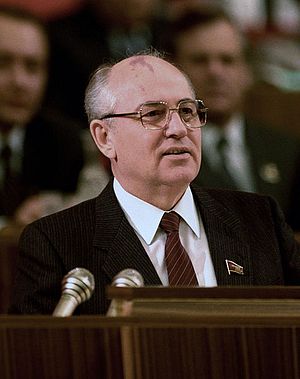Could Mikhail Gorbachev, as Soviet premier during the late 1980s, have resuscitated the Soviet economy and prevented his country’s dissolution? That’s the question Yale’s Chris Miller deftly answers in The Struggle to Save the Soviet Economy. Without undercutting the thrust of Miller’s book, the short answer is: no. And Miller is clear, throughout his perestroika-era narrative, why: “Political paralysis produced by the powerful forces who opposed economic reform was the ultimate cause of the Soviet Union’s collapse.”
Miller’s argument, accessing under-studied Politburo documents, comes at the analysis of the USSR’s dissolution orthogonally. Rather than lay blame at the feet of the 1980s’ oil crunch, as luminaries like Princeton’s Stephen Kotkin have, Miller fits the hydrocarbon downturn within the Soviet Union’s broader budget crises, especially as it pertains to the commensurate drop in liquor tax revenue due to Gorbachev’s 1985 crackdown on alcohol sales. And rather than simply cite the rumblings of nationalism from Tallinn to Tbilisi, Miller points to Moscow’s dessicated budget – and Gorbachev’s inability to buy off regional elites, who soon busied themselves gobbling local industry – as a necessary reality that helped spin Soviet secession.
That’s not to say, of course, that Gorbachev and his raft of reformers were unaware of the Soviet Union’s emerging revenue emergencies. Indeed, all they had to do – and many, as Miller makes clear, did – was look to China for inspiration. From sounder monetary policy to, most especially, agricultural reform, Gorbachev attempted to lift and implement many of Deng Xiaoping’s market-based shifts.
But for Gorbachev — who couldn’t even access Moscow’s defense budget until he’d ascended to general secretary — the reforms were far too little, far too late. Moreover, as Miller argues, the reforms butted against a triumvirate of entrenched lobbies: agriculture, defense, and industrial voices, all clamoring for their own, rather than national, interests. Where Joseph Stalin had resorted to rank executions in order to prevent these lobbies from entrenching, Leonid Brezhnev tacked toward a “stability of the cadres,” effectively marking the path for the agro-military-industrial complex to harden, and to later suck the Soviet Union’s funds dry. (It’s worth pairing Miller’s read with Francis Spufford’s Red Plenty, a fictional run-through of the Soviet economy’s sprint toward stagnation.) As Miller writes, the “Soviet army and its allies were not the solution to the country’s economic problems, they were the cause. The military and its interest group allies were the main reason the USSR had an uncontrollable budget deficit.”
All told, Gorbachev was effectively powerless to stave off the Soviet Union’s implosion without simultaneously uprooting the lobbies stymieing his reforms. Forced to cover a booming budget deficit — while still offering some of the largest agricultural subsidies in history — Gorbachev resorted to printing more rubles, spiraling inflation and increasing shortages. Soon, arguments for secession gained sufficient traction, accelerating after the failed August 1991 coup. And a quarter-century later, we can look at a sprawling post-Soviet region — 15 nations, and all that’s come since — and see the after-effects of what a handful of entrenched, crony interests, looking at only for their own, can accomplish, and can destroy.

































